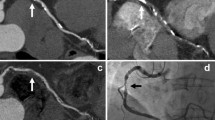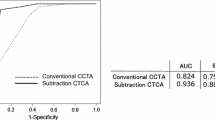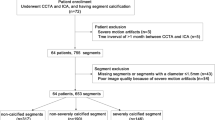Abstract
Objective
To investigate the feasibility of subtraction coronary computed tomographic (CT) angiography (SubCCTA) to decline calcium artifacts and improve diagnostic accuracy in the presence of coronary calcification and analyze the factors that influence SubCCTA.
Methods
A total of 294 patients suspected of having coronary artery diseases underwent coronary computed tomographic angiography (CCTA) and SubCCTA. Coronary stenoses were blindly evaluated by two experienced radiologists, which were compared with invasive coronary angiography (ICA). Multiple statistical indexes were adopted to analyze the value of SubCCTA for the diagnosis of calcium stenoses.
Results
The diagnosable rate of SubCCTA was 67.2% (n=197), and the non-diagnosable rate was 32.8% (n=97). Using SubCCTA, the false positive rate decreased from 56.5% to 17.4%, and the corresponding diagnostic accuracy was increased from 83.6% to 92.9%. Univariate logistic regression analysis showed that height (OR=1.029, 95% CI=1.001–1.058), weight (OR=1.025, 95% CI=1.004–1.046), left ventricular size (OR=1.018, 95% CI=1.007–1.030), cardiothoracic ratio (OR=39.917, 95% CI=1.244–1281.098), the average heart rate (OR=0.866, 95% CI=0.836–0.896) and heart rate range (OR=0.882, 95% CI=0.853–0.912) might be the factors influencing SubCCTA.
Conclusion
This study suggested that SubCCTA could help improve diagnostic accuracy in the presence of calcium plaques. Moreover, several factors were discovered for the first time to possibly influence SubCCTA, which will be helpful in improving the subtracted image quality.
Similar content being viewed by others
References
Yu M, Li Y, Li W, et al. Calcification remodeling index characterized by cardiac ct as a novel parameter to predict the use of rotational atherectomy for coronary intervention of lesions with moderate to severe calcification. Korean J Radiol, 2017,18(5):753–762
Schmermund A, Eckert J, Schmidt M, et al. Coronary computed tomography angiography: A method coming of age. Clin Res Cardiol, 2018,107(Suppl 2):40–48
Sunkara N, Wong ND, Malik S. Role of coronary artery calcium in cardiovascular risk assessment. Expert Rev Cardiovasc Ther, 2014,12(1):87–94
Budoff MJ, Dowe D, Jollis JG, et al. Diagnostic performance of 64-multidetector row coronary computed tomographic angiography for evaluation of coronary artery stenosis in individuals without known coronary artery disease. J Am Coll Cardiol, 2008,52(21):1724–1732
Miller JM, Rochitte CE, Dewey M, et al. Diagnostic performance of coronary angiography by 64-row CT. N Engl J Med, 2008,359(22):2324–2336
Sajjadieh A, Hekmatnia A, Keivani M, et al. Diagnostic performance of 64-row coronary CT angiography in detecting significant stenosis as compared with conventional invasive coronary angiography. ARYA atherosclerosis, 2013,9(2):157–163
Yamaguchi T, Ichikawa K, Takahashi D, et al. A new contrast enhancement protocol for subtraction coronary computed tomography requiring a short breath-holding time. Acad Radiol, 2017,24(1):38–44
Abdulla J, Pedersen KS, Budoff M, et al. Influence of coronary calcification on the diagnostic accuracy of 64-slice computed tomography coronary angiography: A systematic review and meta-analysis. Int J Cardiovas Imag, 2012,28(4):943–953
Yoshioka K, Tanaka R, Muranaka K. Subtraction coronary CT angiography for calcified lesions. Cardiol Clin, 2012,30(1):93–102
Tanaka R, Yoshioka K, Muranaka K, et al. Improved evaluation of calcified segments on coronary CT angiography: A feasibility study of coronary calcium subtraction. Int J Cardiovasc Imag, 2013,29(Suppl 2): 75–81
Yoshioka K, Tanaka R, Nagata K, et al. Modified subtraction coronary CT angiography method for patients unable to perform long breath-holds: A preliminary study. Acad Radiol, 2016,23(9):1170–1175
Yoshioka K, Tanaka R, Muranaka K, et al. Subtraction coronary CT angiography using second-generation 320-detector row ct. Int J Cardiovas Imag, 2015,31(1):51–58
Cademartiri F, Mollet NR, Lemos PA, et al. Higher intracoronary attenuation improves diagnostic accuracy in mdct coronary angiography. Am J Roentgenol, 2006,187(4):W430–433
Cademartiri F, Mollet N, Lugt A, et al. Intravenous contrast material administration at helical 16-detector row CT coronary angiography: effect of iodine concentration on vascular attenuation. Radiology, 2005,236(2):661–665
Abbara S, Blanke P, Maroules CD, et al. SCCT guidelines for the performance and acquisition of coronary computed tomographic angiography: A report of the society of cardiovascular computed tomography guidelines committee: Endorsed by the north american society for cardiovascular imaging (nasci). J Cardiovasc Comput Tomogr, 2016,10(6):435–449
Amanuma M, Kondo T, Sano T, et al. Subtraction coronary computed tomography in patients with severe calcification. Int J Cardiovas Imag, 2015,31(8):1635–1642
Guo W, Tripathi P, Yang S, et al. Modified subtraction coronary CT angiography with a two-breathhold technique: Image quality and diagnostic accuracy in patients with coronary calcifications. Korean J Radiol, 2019,20(7):1146–1155
Kidoh M, Utsunomiya D, Oda S, et al. Optimized subtraction coronary CT angiography protocol for clinical use with short breath-holding time-initial experience. Acad Radiol, 2015,22(1):117–120
Fuchs A, Kuhl JT, Chen MY, et al. Subtraction CT angiography improves evaluation of significant coronary artery disease in patients with severe calcifications or stents-the c-sub 320 multicenter trial. Eur Radiol, 2018,8(10):4077–4085
Author information
Authors and Affiliations
Corresponding author
Ethics declarations
All authors declare no conflict of interests.
Additional information
This study was supported by Hubei Health Committee of China (No. WJ2019M119).
Rights and permissions
About this article
Cite this article
Huang, C., Wan, Wj., Yao, Yh. et al. Feasibility of Subtraction Coronary Computed Tomographic Angiography and Influencing Factor Analysis: a Retrospective Study. CURR MED SCI 41, 821–826 (2021). https://doi.org/10.1007/s11596-021-2413-3
Received:
Accepted:
Published:
Issue Date:
DOI: https://doi.org/10.1007/s11596-021-2413-3




